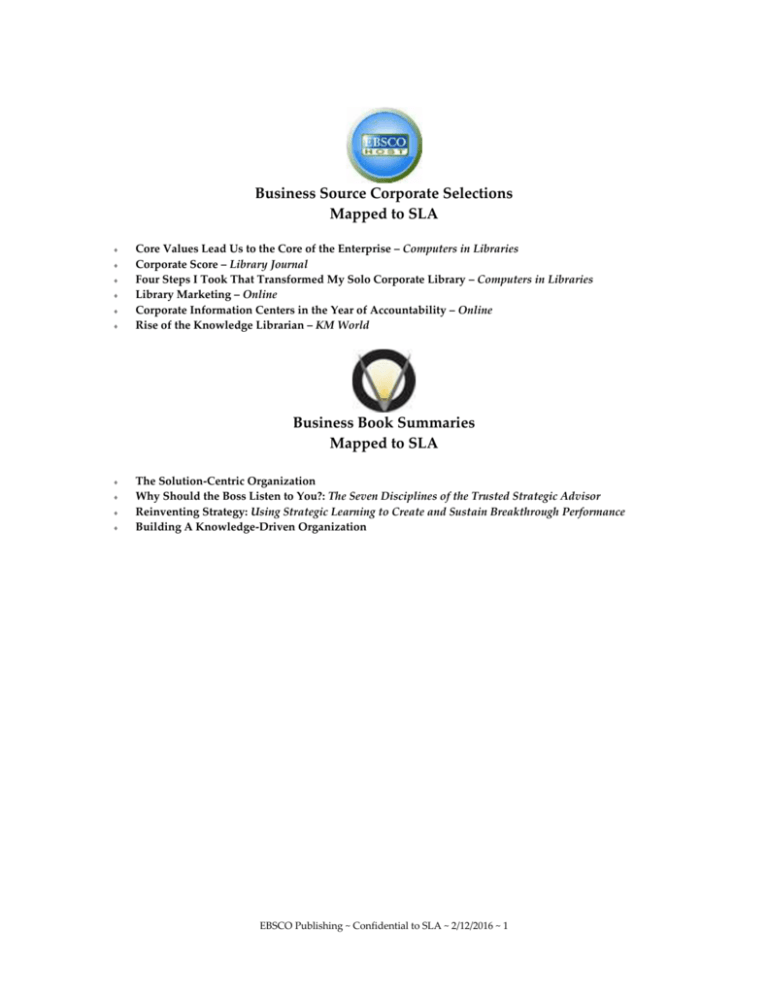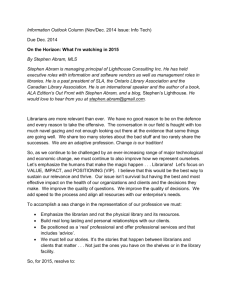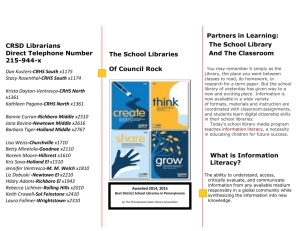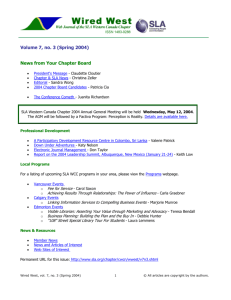BSC mapped to SLA
advertisement

Business Source Corporate Selections Mapped to SLA Core Values Lead Us to the Core of the Enterprise – Computers in Libraries Corporate Score – Library Journal Four Steps I Took That Transformed My Solo Corporate Library – Computers in Libraries Library Marketing – Online Corporate Information Centers in the Year of Accountability – Online Rise of the Knowledge Librarian – KM World Business Book Summaries Mapped to SLA The Solution-Centric Organization Why Should the Boss Listen to You?: The Seven Disciplines of the Trusted Strategic Advisor Reinventing Strategy: Using Strategic Learning to Create and Sustain Breakthrough Performance Building A Knowledge-Driven Organization EBSCO Publishing ~ Confidential to SLA ~ 2/12/2016 ~ 1 Business Source Corporate Selections Mapped to SLA Core Values Lead Us to the Core of the Enterprise Computers in Libraries Jun2009, Vol. 29 Issue 6, p37-39, 3p The article discusses the role of core values in guiding librarians and other information professionals to positions of authority and influence within their firms. The librarian can act as a responsibility aggregator who looks for areas where initiative can make a difference. As an alliance builder, the librarian asks to set up informational meetings with staff from diverse settings. Corporate Score Library Journal 2/1/2007, Vol. 132 Issue 2, p42-43, 2p, 1 color The authors focus on the transition of corporate libraries from an older, warehouse model to one focusing on client-centered uses. The authors discuss how corporate librarians can use the SLA Competencies for Information Professionals and the Balanced Scorecard construct introduced by Robert S. Kaplan and David P. Norton as aids to connect library competency to strategy. Four Steps I Took That Transformed My Solo Corporate Library Computers in Libraries Oct2003, Vol. 23 Issue 9, p22-24, 3p, 1 bw The article presents an article on the transformation of a corporate library. Library Marketing Online Jan/Feb2001, Vol. 25 Issue 1, p52, 3p Explores several methods librarians and research library staff members can consider to attract clients to company libraries or corporate information resource centers; Coffeehouse-bookstore concept of the HewlettPackard Labs Research Library; Ways of advertising the company library and its services; Importance of discussion in company libraries. Corporate Information Centers in the Year of Accountability Online Jul/Aug2001, Vol. 25 Issue 4, p86, 3p The article deals with several tactics to demonstrate the value of corporate libraries or information center. Examples that illustrate a weakly articulated value statement versus a more powerful one; Tips on gathering tangible return-on-investment data; Sample questions designed to get users' opinion on how the library stacks up against the alternatives; View of end-users on corporate libraries. Rise of the Knowledge Librarian KM World Feb2009, Vol. 18 Issue 2, p1-19, 3p The authors reflect on the condition of the knowledge economy and the role of corporate librarians. The authors point out that both the private and public sectors have been steadily downsizing and closing their EBSCO Publishing ~ Confidential to SLA ~ 2/12/2016 ~ 2 physical libraries. They compare the delivering knowledge and information in terms of operations. They noted that corporate librarians used to devote years acquiring and cataloging physical document collections. Business Book Summaries Sample Mapped to SLA The Solution-Centric Organization By: Keith M. Eades and Robert E. Kear Simply bundling products and services and targeting different market segments does not mean a company is selling solutions. Being solution-centric means that an organization defines itself by the problems solved for customers, rather than by the products or services it provides. Every activity within the company, from marketing to research and development to manufacturing, is undertaken with customers and their problems in mind. Value is gauged not just by revenue or earnings, but by the results and positive outcomes that customers achieve through the use of the company's products and services. Moving from product-centric to solution-centric requires a revolutionary new way of thinking and acting, and, according to the authors, requires four fundamental transformations. In The Solution-Centric Organization, Eades and Kear define these transformations and explore how companies can become solution-centric and more competitive in the global economy. View Summary Why Should the Boss Listen to You? The Seven Disciplines of the Trusted Strategic Advisor By: James E. Lukaszewski Professionals, in a wide range of fields, find themselves in situations where they must provide useful and strategic advice to the leaders of the organization. Becoming a trusted strategic advisor requires more than the amount of face time spent with the boss. It means making sure that time spent with superiors and other executives is limited, focused, and in their operational interest. It requires seeing the world from the boss’s perspective. In Why Should the Boss Listen to You?, author James E. Lukaszewski explains the systematic processes for getting to, and working at, the highest levels and having maximum impact as a trusted advisor. In this work, readers will find out how CEOs and other top executives think, understand what matters to them, and how they operate. Trusted strategic advisors will then understand what executives expect and need. View Summary Reinventing Strategy Using Strategic Learning to Create and Sustain Breakthrough Performance By: Willie Pietersen According to Pietersen, today’s new leadership challenge is a journey of discovery in which management, particularly in large, established firms, must learn to “think out of the box” and “move out of their comfort zones,” in order to create and lead adaptive organizations that change and innovate continuously. The objective is not learning for learning’s sake, but learning strategically so as “to build an organization that continuously learns new things and [repeatedly] translates them into breakthrough strategies.” EBSCO Publishing ~ Confidential to SLA ~ 2/12/2016 ~ 3 Reinventing Strategy distills the author’s extensive experience, both as a CEO and as a teacher, consultant, and researcher at Columbia Business School, to offer a set of operating principles and a leadership process— Strategic Learning—that has proven effective in enabling business leaders to develop superior insights, transform them into winning strategies, and foster adaptive enterprises. View Summary Building a Knowledge-Driven Organization By: Robert H. Buckman If knowledge is power, then knowledge shared is knowledge multiplied. For many years, the knowledge that Buckman Laboratories, an international specialty chemical company in business since 1945, brought to its customers was limited, for the most part, to that of the individual employee working with a customer. Soon, Bob Buckman, now chairman and CEO emeritus of the company and author of Building A Knowledge Driven Organization, came to realize that if the company’s collective knowledge could be brought to bear on a customer’s problem, the speed—as well as the quality—of the solution for the customer would be greatly enhanced. The challenge would be in learning how to move the knowledge around the organization in time for it to be useful, which implied having the technological capability to locate and move the knowledge, and having the kind of corporate culture that not only permitted, but encouraged, knowledge sharing as opposed to knowledge hoarding. View Summary EBSCO Publishing ~ Confidential to SLA ~ 2/12/2016 ~ 4





